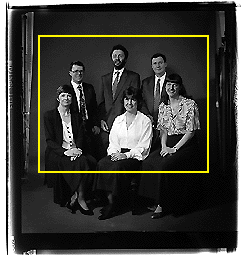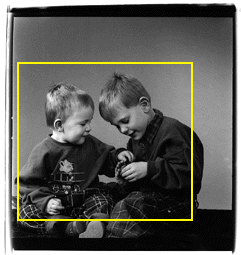

When contact prints were the only method of reproduction, it made sense to compose completely within the format used. Small originals like 35mm also benefit from full-frame printing, and transparencies for AV shows often must be used uncropped. Zoom lenses help greatly when using this format.
The argument that cropping leads to increased grain and loss of definition no longer applies with modern rollfilm emulsions. These days, for all practical purposes, it is irrelevant.
The argument that failure to compose accurately in the camera is the result of inadequate thought doesn't stand up, either. There are many factors - time, distance, perspective, limitations of equipment - that may make the optimum viewpoint one which does not fill the frame. You may take a photograph with the full intention of subsequent cropping.
There is only one very sound reason for composing every shot to fill the frame, especially for weddings and portraiture - most prints are machine-printed at fixed sizes. 6 x 6cm negatives will be printed straight off to 5 x 5" or 8 x 8" in 90 per cent of cases. The photographer may exercise some editing by choosing a 4 x 5" or 6 x 8" overlay, but that will be the limit of his cropping. When larger sized hand prints are made, iwe can be as selective as we like, but for most reprints we will again have fixed size machine enlargements.
The result of this is that often, when looking through a wedding or portrait album, I find myself cringing at the need for cropping some pictures show in order to improve the overall effect. This never used to be a problem, because a generation ago every professional photographer made his own black and white prints in his own darkroom.
Most of today's photographers do not have darkrooms, and it would not make economic sense to hand-print colour weddings anyway. Consequently very little thought is given to cropping. As soon as prints are back from the lab they are slipped into mounts with never a thought that a creatively cropped good picture could become an excellent one.
Cropping as a means of correcting faults, of cutting out extraneous items not seen which should have been (!), or of having second thoughts about the tightness of the composition, should be regarded as an essential and regularly used process.
But it is also legitimate and creative to take photographs with every intention of subsequent cropping. Here are two examples:

A. A family group of six people in the studio; space is tight and they must fit within your background roll's limited width. You cannot get far enough away to use your 150mm lens, so it has to be the 80mm. Composing a full frame half-length view in the camera for this group gives you three problems:

B. Two children aged two and four are proving very active in the studio. You need to give them plenty of space to move in, even though you are hoping for some good close-ups. You also need adequate depth of field. The easiest way to achieve this is to keep the camera far enough away for movement to either side, forward or backward can be accommodated without adjustment. Armed with a remote release, you can concentrate 100 per cent on coaxing the children into the pose and position you want and maintaining contact with them rather than being lost behind the camera, maybe in the shadows.
Take photographs with the intention of cropping; you can safely do so using ISO 100�160 film with its minimum granularity and great sharpness.
Obtain prints or transproofs as usual, but crop them before showing. Transproofs are easily foil masked and the projector zoom lens does the rest.
With prints, crop them with a trimmer and spray-mount them on to plain card of one standard size. Never mind that the images are not all of a uniform size.
If you are using your local lab for machine prints you may be able to order the 'next size up' - a lot cheaper than a selective enlargement.
There is another way, which costs no extra. That is to employ a laboratory that uses crop cards. With this system, you tape the negative to a carrier card, over an aperture corresponding to a final print size and degree of enlargement. For a 6 x 6cm negative you can tape it on any one of six cards, each with a different sized aperture. Printed lines on the card tell you exactly what you will see on different possible print sizes. You receive cropped prints while paying machine print prices; it is surprising that crop cards are not offered by more labs. Perhaps too many photographers are indifferent � they have never experienced the lost art of cropping.
The system originates in the United States, where it is popular with labs serving portrait photographers. It is made by Think Inc in conjunction with Lucht and Bremson, enlarger system and lab data processing specialist suppliers.
The only laboratory in the UK that I am aware of that uses crop cards is Colorworld Limited, PO Box No 2, Norham Road, North Shields, Tyne and Wear NE29 0NX.